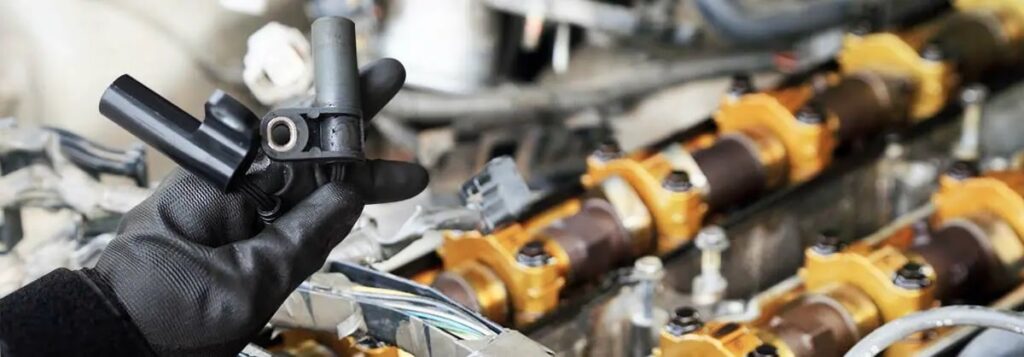
Camshaft Sensor Repair – The camshaft sensor is one of the most important components of any modern automobile’s engine. The camshaft sensor is located under the hood, next to the engine, but it isn’t always easy to find. However, no matter what vehicle you drive, your camshaft sensor will be in one of these three locations: next to the engine block, behind the cylinder head, or in the lifter valley.
The camshaft sensor is a small but important magnetic device. It gathers and transmits information about the car’s camshaft speed – and the position of each piston – to the car’s electronic control module. This information is used by the vehicle’s computer to calculate the engine’s ignition and fuel injection timing, which are vital for engine function.
After time, the camshaft sensor can weaken due to wear and tear. When it fails, the weak or disrupted signal is interpreted as a problem by the computer. This will affect the smoothness of the vehicle’s engine, and should be repaired or replaced as soon as possible. Here are some symptoms of a failing camshaft sensor:
Camshaft Sensor Repair – The camshaft sensor is one of the most important components of any modern automobile’s engine. The camshaft sensor is located under the hood, next to the engine, but it isn’t always easy to find. However, no matter what vehicle you drive, your camshaft sensor will be in one of these three locations: next to the engine block, behind the cylinder head, or in the lifter valley.
The camshaft sensor is a small but important magnetic device. It gathers and transmits information about the car’s camshaft speed – and the position of each piston – to the car’s electronic control module. This information is used by the vehicle’s computer to calculate the engine’s ignition and fuel injection timing, which are vital for engine function.
After time, the camshaft sensor can weaken due to wear and tear. When it fails, the weak or disrupted signal is interpreted as a problem by the computer. This will affect the smoothness of the vehicle’s engine, and should be repaired or replaced as soon as possible. Here are some symptoms of a failing camshaft sensor:
- Check Engine Light
The first symptom of a failing camshaft sensor manifests as a warning from the car’s control module. As the camshaft sensor fails, the computer sends the driver a warning sign via the “check engine” light on the car’s dashboard. When the check engine light first comes on, the driver has enough time to service the car and replace all faulty parts, including the failing camshaft sensor. However, if you ignore this flashing light for a considerable time, it could later lead to severe engine trouble.
- Disrupted Driving
Another symptom of a failing camshaft sensor is experiencing constant disruption while driving. If you are experiencing symptoms like frequent stalling, poor idling of the car at 500 to 600 rpm, a massive drop in the rpm when decelerating to a stop, a noticeable drop in engine power, poor mileage, abnormal acceleration activity, frequent stumbling, etc., it probably means you have a failing camshaft sensor that needs immediate attention. If you are experiencing any of these symptoms, it is best to seek a mechanic before the situation gets worse and the car gives up, refusing to start at all.
- Ignition Trouble
If you ignore all of the above symptoms, you end up with one that really can’t be ignored – no ignition. As the sensor begins to weaken, so does the signal it transmits to the car’s computer. If you let the problem carry on for too long, the engine will suffer from a “no spark” situation. Once the signal switches off, so will your engine, stranding you. If your car gets to this stage, you will most likely have to have it towed to the nearest shop, causing you a huge inconvenience and expense.
The first symptom of a failing camshaft sensor manifests as a warning from the car’s control module. As the camshaft sensor fails, the computer sends the driver a warning sign via the “check engine” light on the car’s dashboard. When the check engine light first comes on, the driver has enough time to service the car and replace all faulty parts, including the failing camshaft sensor. However, if you ignore this flashing light for a considerable time, it could later lead to severe engine trouble.
Disrupted Driving
Another symptom of a failing camshaft sensor is experiencing constant disruption while driving. If you are experiencing symptoms like frequent stalling, poor idling of the car at 500 to 600 rpm, a massive drop in the rpm when decelerating to a stop, a noticeable drop in engine power, poor mileage, abnormal acceleration activity, frequent stumbling, etc., it probably means you have a failing camshaft sensor that needs immediate attention. If you are experiencing any of these symptoms, it is best to seek a mechanic before the situation gets worse and the car gives up, refusing to start at all.
Ignition Trouble
If you ignore all of the above symptoms, you end up with one that really can’t be ignored – no ignition. As the sensor begins to weaken, so does the signal it transmits to the car’s computer. If you let the problem carry on for too long, the engine will suffer from a “no spark” situation. Once the signal switches off, so will your engine, stranding you. If your car gets to this stage, you will most likely have to have it towed to the nearest shop, causing you a huge inconvenience and expense.
If your vehicle’s camshaft sensor is malfunctioning, come in to your Certified Auto Repair Specialist of Pasadena today, and we will take care of you.

